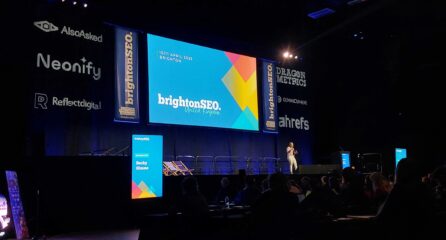Last week the whole Loom team made its annual visit to the Brighton SEO conference. As well as our obligatory touristy trip to the pier (where we managed to squeeze in a few arcade games) and tucking into some delicious food at our favourite Mexican restaurant, we did find time to attend some fantastic talks. We’ve summarised all of the best bits from the conference for you including some key actionable takeaways:
Social Media
Bringing People Together using Facebook Groups
Now that brand page reach on Facebook has diminished significantly, this talk spoke about how Facebook’s group communities are the new hotspot for engagement. Groups provide users with a safe space to share content and engage freely with each other – and with the brands!
This engagement is being rewarded by the Facebook algorithm, with some high performing group postsperforming up to 70% higher than even boosted page content. With Facebook desperate to keep its users sharing on Facebook – a behaviour that has declined in recent years – it makes sense that they’re focusing on nurturing its group communities.
So, what have Facebook done to help group communities grow? Well, they’ve provided a whole new range of admin tools to make it easier to manage groups. Brands can now link their groups with their pages, and soon they’ll be able to customise groups with colours and themes. Tags can also be used to help people find the types of groups they’re looking for. Even advertising is on the cards, potentially giving marketers a brand-new pool of engaged users in a totally different environment to the never-ending scroll that is Facebook’s newsfeed…
Ultimately, Facebook groups are communities where, if done well, you’re able to nurture a warm and positive attitude towards your offering and your brand. It’s a place to genuinely engage people. Interruptive marketing doesn’t have a place here. In fact, selling needs to be kept to an 80/20 minimum. Groups promote a different type of Facebook marketing, and when utilised to build trust and advocacy they can actually negate the need for a hard sell completely.
Facebook Location Structures
If you have a multi-location business, you should be using Facebook Location pages. These location pages allow users to check into your store or branch, and helps drive local awareness.
Without your own official location page, you are at risk of the UFLoPs. This is the term given to Unofficial Facebook Location Pages which are set up by users when they can’t find an official location page to check in to. The problem with UFLoPs is that you have no control over them. You cannot manage them, mediate the comments or officially respond to reviews.
The first step in claiming back your official location-power is to audit unofficial pages and either claim them or ask Facebook to remove them. Next, it’s time to set up your official Location pages. There are three key points to remember here:
- Use location specific URLs – this is much better for SEO and will help people find your pages easily
- Ensure there is consistent branding across the pages – this includes the logo and cover photo
- Choose your posting strategy. Location pages automatically share posts from the main brand page, you can choose to leave this on, turn this off entirely, or have a mixture of both which is recommended for stores / branches which prefer to post their own location-specific updates.
Optimum structure of multi-location businesses
Technical SEO
Featured snippets: from then to now, volatility and voice search
Rob Bucci, CEO of STAT, did an interesting talk on featured snippets using sample data from one million search queries. Quite surprisingly, his research demonstrated that 31% of searches returned a snippet.
If you aren’t sure what these are, Google has introduced Snippets over the last couple of years. They display at the top of all organic results when a user asks Google a question and are a box with content extracted from a page, in the format of either a list, paragraph or table.
The value in owning a featured snippet is that it demonstrates that your site is an authority on the subject – without necessarily ranking number one in the SERPs. It is an advantage occupying the snippet box in position 0 as it is better real estate.
Rob discussed the volatility and inconsistencies around when the snippets appear. His research found that in the case of the 233,000 search queries where a snippet appeared, 68% showed no volatility, with only 8% disappearing and not coming back. There was a correlation between higher volatility and the further down the SERPs the snippet was generated. This all becomes particularly interesting when it comes to spotting trends and understanding how to better appear for a snippet (in line with how people search online) Snippets are likely to tie in with how voice search queries work in the future.
He concluded that you should strive for the best organic ranking to be in with the best chance to appear in a snippet box. Back to it then!
HTTP2
Tom Antony at Distilled delivered a really informative, visual talk on the Move towards HTTP2. He explained the importance of HTTP2 and how sites should be moving towards this protocol.
The current set up with HTTP1 means that messages are sent between the browser and the server at the speed of light. It means the requests can only be transported individually.
If you have more connections, each load time goes down, and the speed of a site goes up. HTTP2 allows multiple connections and so is the ultimate way to increase site speed. The HTTP2 protocol also allows ‘server push’ meaning the browser doesn’t need to send individual requests to the server to send data.
Will Google notice HTTP2?
Although Google Bots won’t use the protocol to crawl a site, Google uses Chrome Usage Data to measure the site speed. So, implementing HTTP2 on your site will affect how google ultimately views it.
To implement, you could use a CDN (Content Delivery Network) or a cloud-based system. Alternatively, your server may already be able to implement the protocol, in which case you simply need to turn it on at the server.
NOTE: You must have your site on HTTPS in order to use the HTTP2 protocol.
Optimising for Google Bots
Some simple, top tips from Fili Weise on how to optimise your site for Google Bots:
- Google Bots crawl a site from the top down when they FIRST visit your site. Make sure your site hierarchy is well structured, with your most important pages at the top. Going forward the bots crawl randomly, once they think they understand a site.
- Internal linking assists crawlers immeasurably, so make sure you have lots of strong internal links.
- If you’re considering a site migration, make sure you improve all your SEO signals first before moving over. This is because after a migration, you’ll be assigned a new crawl budget and you want to present Google with a high-quality site to make the most of this.
- Conduct technical audits of your site regularly.
Structured Data
Alexis Sanders from Merkle Inc delivered an accessible talk, great for developers, that contained some useful nuggets.
Structured data is essentially information with a high degree of organisation. If text is organised using it, then it’s much easier for Google’s algorithms to process.
Structured data supports voice search too and allows merchant centre feeds to be integrated more seamlessly.
Use this Schema Markup tool to generate structured data or if you have more technical ability, Webdatacommons is a useful resource.
Particular sectors that will see a benefit from using structured data in the near future are Publishing, E-Commerce and Health.
Search Strategy
Selling across search engines & multi-channel approach
As voice search, micro-search engines and marketplaces become more common, Katherine Khoo encouraged marketers to move away from selling products on Google and social media alone.
79% of shops have a brick and mortar store and 73% of businesses have a website, while only 21% of these businesses are running a multi-channel strategy. This gives marketers a great chance to get ahead by covering as many customer touchpoints as possible.
Voice Search
70.6% of all UK voice searches in the UK are on Alexa, meaning that you can put your products front and centre when shoppers need them most. Alexa prioritises products that are “Amazon’s choice” rather than the top search result. This means that optimisations need to be done for each channel specifically, which becomes even more important when you consider that 45% of product searches now start on Amazon.
With new tools cropping up regularly, such as Sonar for Amazon keyword research, and Shopping specific search engines such as Pricesearcher offering consumers a different buying experience, marketers can no longer rely on the old guard for maximising their online potential.
Paid Search
Utilizing Google AdWords scripts for extracting information and creating beneficial reports
Scripts were mentioned a lot at BrightonSEO. Particularly useful were the free open source Google AdWords scripts designed to serve different purposes.
The first script helps find your best or worst search queries using N-grams. This can extract search phrases and present them in a nice Google Sheet report. The advertiser is then able to deduce whether certain sized N-grams provide better conversion rates or return on ad spend (ROAS) percentages. It can also be used for keyword research.
Additionally, we encountered scripts that create heat maps for day & device, and one that scans landing pages for 404 error pages / broken URLs and subsequently pauses those ads to stop unnecessarily wasting budget.
Scripts can also be used for bid management. Some examples are weather-based campaign management, real-time position bidding & 24-hourly bid scheduling.
Loom
If you need strategic support with your search marketing or biddable media then contact the Loom team today. Call 0117 923 2021.





